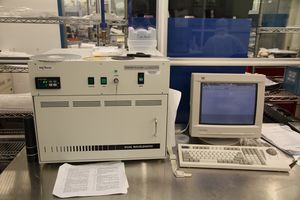Film Stress (Tencor Flexus): Difference between revisions
Jump to navigation
Jump to search
Content deleted Content added
Added Documentation Section |
|||
| Line 23: | Line 23: | ||
*Substrates must be round and films must be reflective. |
*Substrates must be round and films must be reflective. |
||
*Fixtures are available for 2, 3, 4, 5, and 6" wafers. 8" wafers can be ran as well without a fixture. |
*Fixtures are available for 2, 3, 4, 5, and 6" wafers. 8" wafers can be ran as well without a fixture. |
||
== Documentation == |
|||
* Tencor Flexus Standard Operating Procedure |
|||
Revision as of 17:29, 19 April 2021
|
About
The Flexus instrument is used to measure the stress introduced onto a wafer after thin-film deposition by measuring local curvature of a wafer. The system uses a scanning laser detector configuration to measure the surface position of a wafer across its diameter. With automatic rotational control, a 3-D map can also be obtained. By comparing before and after measurements of the sample, the local stress of the sample can be calculated from the local curvature. The stage can also be heated up to 500°C to measure thermal mismatch of the thin films with the substrate.
Equipment Specifications
- Measurement range is 2E7 to 4E7 dyne/cm2
- Stress can also be measured as a function of time or temperature. The system has a temperature range from room temperature to 500°C.
- Measurement results are organized in an easy to read spreadsheet format that can easily be exported to other data handling software such as Excel.
- Windows 3.xx control and file storing
- 3-D mapping
- Laser/Detector Scanning Configuration
- Substrates must be round and films must be reflective.
- Fixtures are available for 2, 3, 4, 5, and 6" wafers. 8" wafers can be ran as well without a fixture.
Documentation
- Tencor Flexus Standard Operating Procedure
